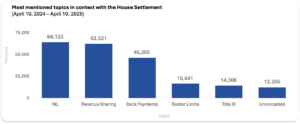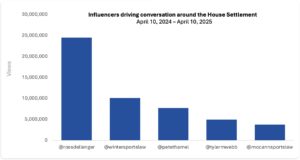With a decision imminent in the House Settlement—arguably the most consequential turning point in the history of college athletics—Legend Labs conducted an in-depth analysis of how public discourse around this landmark case has evolved over the past year.
Using advanced digital listening tools like Meltwater, Radarly, and BuzzSumo, we analyzed the online conversation to uncover key trends: identifying who is shaping and influencing the discussion, which core topics are capturing public and media attention, and how university officials are responding. A few notable insights from our research include:
- House Settlement conversation only accounted for a mere 1% of the total mentions around college athletics for the past year.
- Of the top 100 influencers driving coverage on X/Twitter, approximately 10% were Lawyers while less than 5% were current or former athletes.
Legend Labs is a brand and communications consulting firm for the digital age. We help ambitious leaders create, grow, and protect their Legends. For inquiries, please reach out to us at hello@legendlabs.com.
Topic Drivers
Which elements of the settlement are driving the most coverage?

- Name, Image & Likeness (64,122 mentions)
- Revenue Sharing (62,521 mentions)
- Back Payments (46,305 mentions)
- Roster Limits (16,641 mentions)
- Title IX (14,306 mentions)
- Unionization (12,305 mentions)
Notable Influencers
Which influencers are speaking out about House, and what are their positions on the Settlement?

#1 Ross Dellenger, Reporter
- Total Posts: 269
- Views Per Post: 92,000
- Followers: 116,800
- Position: Neutral, matter-of-fact reporting on college athletics’ commercialization through insider access to conferences and key decision-makers.
#2 Mit Winter, Lawyer
- Total Posts: 850
- Views Per Post: 29,000
- Followers: 14,000
- Position: Antitrust skeptic who views the settlement as a flawed stopgap that fails to create a legally sustainable model by imposing unilateral salary caps without athlete bargaining rights.
#3 Pete Thamel, Reporter
- Total Posts: 41
- Views Per Post: 188,000
- Followers: 321,000
- Position: Breaking news reporter who focuses on delivering insider developments about vote counts, financial details, and procedural steps while framing the settlement as “historic” yet filled with ambiguity and looming complications.
#4 Tyler Webb, Reporter
- Total Posts: 4
- Views/Post: 1.2M
- Followers: 6,700
- Position: Sports business analyst focusing on the implications for athlete unionization and employee status.
#5 Michael McCann, Lawyer
- Posts: 237
- Average Views/Post: 16,000
- Followers: 70,000
- Position: Legal educator focused on dissecting procedural hurdles and legal weaknesses in the settlement; consistently emphasizes that it won’t end the NCAA’s antitrust problems nor prevent athlete employment litigation.
Leaders Driving Coverage
Which leaders are featured the most in coverage?

While NCAA President Charlie Baker and the Power-4 commissioners have dominated the spotlight, college leaders from various institutions have contributed to the discussions in meaningful ways.
Athletic directors signaled upcoming structural shifts in their departments through a range of communications strategies.
Coaches were split—some welcomed the clarity and change, while others lamented the potential loss of walk-ons and parity.
University presidents, for the most part, stayed quiet, leaning on their athletic departments to do the talking.
Here are the most notable communications strategies that emerged over the past year:
Internal Address to Constituents:
Danny White, Athletic Director, Tennessee: “This (10% talent fee) will help fund the proposed revenue share for our student-athletes, enabling us to attract and retain the best talent to Rocky Top.” (Link)
Brian Felt, Athletic Director, Seton Hall: “We will not lose sight of our student-athlete-centric model in which young men and women come to Seton Hall to compete at the highest level and graduate with a first-class degree.” (Link)
Jonathan Levin, Interim President, Stanford: “The amount we make available for revenue-sharing with student-athletes will depend on the amount of incremental athletics revenue and philanthropic support we receive.” (Link)
Kevin F. Hallock, President, Richmond: “Athletics brings generations of Spiders together, strengthens our ties with the surrounding region, and offers a platform to showcase our remarkable university on a national stage.” (Link)
Public Town Hall:
Chris Del Conte, Athletic Director, Texas: “(In) every single one of those sports, our obligation, my obligation, is the funding of the highest level.” (Link)
Michael Alford, Athletic Director, Florida State: “It’s really going to clean up where we’ve been in this wild west atmosphere we’ve had the last few years.” (Link)
Exclusive Interview with Media:
Greg Byrne, Athletic Director, Alabama: “The mentality out there is that: ‘They have the money, they can do it.” I haven’t found the secret gold bars under Coleman Coliseum or Mal Moore (Athletic Facility). We have a budget we have to manage.” (Link)
Colin Hargis, Athletic Director, Florida Gulf Coast: “In a perfect world we wouldn’t be part of that, right? We wouldn’t have to pay the debt of others.” (Link)
Michael Crowe, President, Arizona State: “The most important thing that we’re doing is restructuring the entire design of our athletic program, so that it will operate in the transformative ways that we’ve operated the rest of the university, rather than just being what’s called an auxiliary unit.” (Link)

